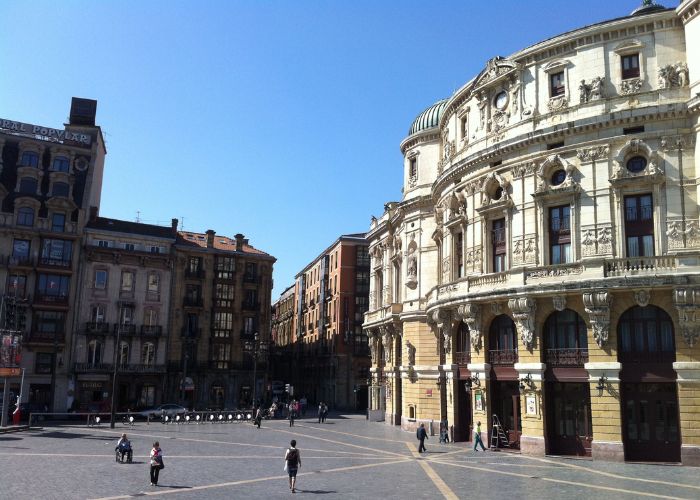Those who only know Bilbao from before the Guggenheim Museum is in for a surprise. The transformation from an important industrial centre to an interesting tourist destination is remarkable and the fact that this transformation is far from complete is promising.
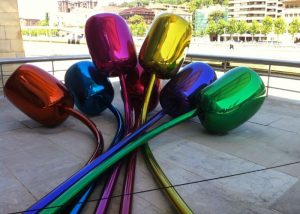
Book a stay in Bilbao itself or the beautiful surroundings. Today, Vueling flies daily to the Basque capital. Of course, the Guggenheim Museum is an undisputed highlight, but Bilbao offers more than this titanium-plated futuristic building by Frank O. Gehry, which forms the basis for the art of great names such as Andy Warhol, Gilbert & George, Louise Bourgeois, and Jeff Koons. We were impressed by the way Bilbao is making short shrift of its rich industrial past as a major shipyard and industrial city focused on steel and iron.
For the month of July, InSpain.news takes an in-depth look at the Basque Country as part of our #TravelTuesday series. Each month we look at a different area in Spain to bring you the best it has to offer. However, today we focus on Bilbao, the Basque capital.
Somos agua
The best way to see this is by taking a boat trip on the Nervión River that crosses the city. ‘Somos agua’, is the winged expression of the true Bilbeños. It means ‘we are water’ and indicates how the city has traditionally been linked to water. Just under ten kilometres bridges the distance between the city centre and the sea.
Getxo is located there on the wide estuary that opens into the Bay of Biscay. This is the chic suburb of the city. The left bank of the Nervión with the towns of Barakaldo, Sestao and Portugalete was reserved for steel and metal works, shipbuilding, and the homes of factory workers. On the right bank of the river with the towns of Erandio, Leioa, and Getxo, the factory owners built their villas. They did this so they could keep an eye on their industrial sites on the other side. The boat trip takes us along the famous Puente Colgante and ends in the marina of Getxo.
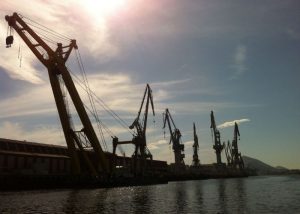
The river
We board the boat after we have exchanged the Guggenheim Museum by scooter for the Maritime Museum Ría de Bilbao. Here we learn more about the influence of the water on the course of Bilbao’s history. The austerely designed building, strongly reminiscent of a gigantic container, stands on the site where the shipyard was located until its closure in 1984. The red crane and a large iron chain are other clear references to the recent past of this place
We are lucky with the weather. After a lot of rain, it is finally dry and sunny. That is certainly not a given in this area, as we learn from the intense green appearance of the area. First, we sail a bit back to the Guggenheim museum. From the water, the building is even more impressive. Here, it can be admired in its full size better than from the side.
When we sail out of the centre, the buildings disappear and we alternately see dilapidated factory sheds and abandoned industrial estates on the left bank. The right bank shows many crooked houses filled with squatters awaiting the inevitable fate of the wrecking ball. Building activities here and there already refer to the near residential future that the city council has in mind for this area.
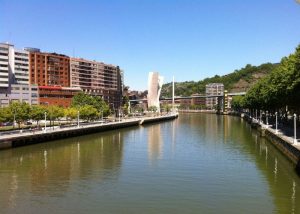 Hanging bridge
Hanging bridge
When we sail for a while, a special steel construction looms in the distance. The guide starts to tell about this ‘Puente Colgante’, the hanging bridge. Only when we approach the wonderful bridge do we see the large gondola that hangs from the structure with steel cables and takes people with their vehicles from one bank to the other. This bridge is the only Spanish industrial heritage on the UNESCO list and was added to it in July 2006. This oldest transport bridge in the world opened in 1893. In the heyday of the industrial revolution, a solution was sought here to bring the many inhabitants of the right bank to their work on the other side of the river without hindering the busy traffic over the water.
Alberto Palacio, one of Gustave Eiffel’s students, designed the bridge together with engineer Ferdinand Arnodin. The engineer conceived the highly innovative lightweight steel twisted cables at the time. For example, no enormous construction was needed that also had to be opened and closed to allow the large ships to pass. The bridge is still functioning and service was only interrupted for four years after a bombing raid during the Spanish Civil War. Tourists can now take a lift up one of the two 60m high poles to enjoy the spectacular view of the harbour and river from the top of the structure.
When we sail past it, the gondola leaves just behind us. It must be something special to experience when you visit Bilbao. The crossing costs less than €1 and a little more if you go by car. You can visit the passage at the top for €9.50. Retirees and children from 5 years old pay €7.50. If you come by metro line 1, get off at Areeta, and on line 2, choose the Portugalete stop.
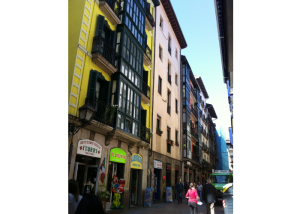
Getxo
The river gets wider as we get closer to its estuary in the Bay of Biscay. There we moor in the marina of El Abra-Getxo. On the other side, we see the place Zanturtzi. Getxo is teeming with people who have come out en masse at the beginning of the evening to enjoy the beautiful weather. They sit on the steps by the harbour, on terraces, and along the quays. We walk up to admire the white houses that are strongly reminiscent of the ‘pueblos blancos’ that are so typical of Andalucia. However, the houses are brighter here, with brightly painted doors, windows, and balconies.
In many of the cobbled streets, you can find delicious ‘pintxos’ (small, culinary masterpieces often on a piece of bread with a skewer in it) or ‘banderillas’ (a skewer with different types of food such as pickles, onions, olives, and cheese). Right behind the narrow streets, you will find Ereaga Beach, which is popular with surfers. If you don’t want to go by boat, you can also take line 1 of the metro and get off at the Gobela or Neguri stop to visit Getxo. The journey takes just under half an hour from Bilbao’s old town.
Interesting facts
Inhabitants of Bilbao are nicknamed Botxeros. This is derived from ‘el botxo’, which means pit and refers to the location of the city in a pit between rolling, green hills.
The basement of the Carlton Hotel in the heart of the city centre served as headquarters for the Basque government during the Spanish Civil War and is fully reinforced with bomb-proof concrete. Pictures of celebrities who were here hang on the walls.
The top floor of the same hotel is the royal suite. A kitchen was built especially for guest Luciano Pavarotti so that the Italian opera singer could cook his pasta.
Everywhere in the historic centre of Bilbao, you can see a difference in the colour of the buildings between two and five metres in height. This line is the result of the severe flood in 1983, which flooded the entire old city. That day, more than 500 litres of water per square metre fell.
British architect, Norman Foster
The Bilbao Metro was designed by British architect Norman Foster. Furthermore, it was once known as the best metro in the world due to its modern architecture. The entrances to the metro stations are still called ‘fosteritos’.
The titanium plates that cover the Guggenheim Museum refer to the iron industry that made Bilbao great. Frank Gehry used 33,000 of those plates that together weigh over 50 tons (Guggenheim-bilbao.es).
When Atlético Bilbao plays football, you can hear their fans shouting ‘Alirón, alirón, el atletic es campeón’ in the crowd. This word comes from the miners looking for iron rejoicing in English ‘all iron! (all iron) ‘ when they had made a good find. Over time, it was translated into “alirón,” which still expresses great joy today.
A gigantic wine store in the new city centre was transformed in 2010 by Philippe Starck into the multifunctional cultural centre Alhóndiga. If you stand in space and look up, you don’t see them flying, but swimming. The transparent bottom of the municipal swimming pool forms the ceiling. Drink or eat something on the roof terrace with beautiful views of Yandiola.
Also read: The Basque Country is quite unlike the rest of Spain
